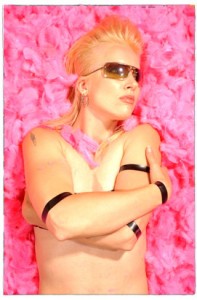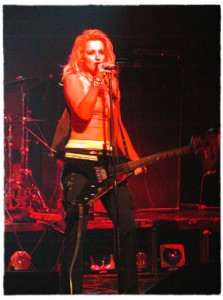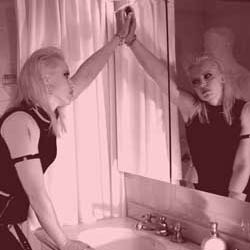Getting Cuts on Commercials: Salme Dahlstrom Storms Synch Licensing
LONG ISLAND CITY, QUEENS: Before Salme Dahlstrom released her debut album, The Acid Cowgirl Audio Trade, she didn’t know a synch license from a stoplight. Now, Salme knows synch licensing.
Every track from that disc has been synched to picture, getting tapped by top brands such as Vodafone, Nike, MTV, Chips Ahoy, Miller Lite, Subaru, Quiznos, Bank of America. TV and film pairings include “One Tree Hill,” “Veronica Mars,” “Laguna Beach,” “The Real Housewives of Orange County,” and “Ice Age 3.” Now, the newest campaigns for Suave and Juicy couture feature her song “C’Mon Y’All”.

Salme Dahlstrom
With synch licensing being one of the most important revenue streams for working artists today to understand, we thought we’d pick the brain of this synch-savvy, 5’11” Swede.
Q: You say that licensing music for visuals was the furthest thing from your mind when you started writing for the album, “The Acid Cowgirl Audio Trade”, yet every track on the record got a synch license. Looking back, what makes these songs work so well for commercials and other synch applications?
A: Upbeat, fun electronic pop/dance songs with catchy vocal and musical hooks seem to set the right mood for many commercials, movies etc… — something I had no idea about when I recorded the songs for my album. I had no expectations of landing any licensing gigs – I hardly knew what licensing was.
Q: Seems like you know now! How did you get your first synch placement? What were the important events that led up to it?
A: One day a licensing agent named Luke Eddins called me up — he runs a licensing company for indie artists called Luke Hits. He had heard my music on Garageband, which was a popular indie artist music site at the time. Luke thought my music was a perfect fit for licensing and he started pitching my songs.
One night he called me and said that a client of his was looking for a song in the vein of my songs, but with a specific message. Would I be interested in producing a track on spec? I basically had three hours to write and produce a song. That’s how, “Take It Off Baby” was conceived and that’s how I got my first placement, which was a Dove commercial.
Q: Nicely done. Which specific placement or placements do you think has been the best use of one of your songs? Why?
A: Without a doubt the placement of “C’mon Y’All” in the Suave commercial. The spot and the song just clicked, it was a great boost for my album, both sales and promo wise …and Suave got a great deal out of it as well!
Q: Is it hard NOT to think of sync-ability as you write your next disc? Do you find yourself wondering if a song is going to work for picture as you write it?
A: I guess at times, yes. But I try not to go there, cuz I have discovered over the years that whenever I try to figure out what the “smart” move is, it never works as well as when I go with my instincts and just do what I do. Believe me, if I could figure out the formula for a “hit” I would bottle it and sell it to the highest bidder.
Q: Sold! But seriously…It may sound obvious, but why do you think having an understanding of synch licensing is important for emerging artists?
A: You want to learn as much as you can about the business you’re in, so that you can make the best deals possible for yourself and not get taken advantage of.
Q: Switching gears, here — what’s in your NYC studio? Let us know the essential hardware and software, and why you selected some of those items.
A: I run a G5 Apple computer with Logic 8 pro — Logic 9 is sitting on my desk but I need to upgrade my computer to run it. It will happen soon.
My audio interface is a Digidesign DIGI-002. I have a Neumann U87 microphone that I run through an Avalon VT737sp pre-amp — a classic setup that I think still gets you one of the best sounds both for vocals and guitars.
The only hardware keyboard I own is a Virus TI. I love the sounds, the interface and that I can control all knobs both from the keyboard and the computer. Plus it’s blonde — like me…
I use a bunch of software keyboards: Rob Papen’s Predator and Albino, REfx Vanguard, Native Instruments Massive and Spectrasonics Stylus RMX. I am looking to get Trilian very soon and I am also curious to try out Ableton Live, I hear a lot of good stuff about it. And then off course I use all the Logic synths, ES1 and ES2, etc… My main sampler is the EXS24, I find it really easy to use plus I love the filters on it. For vocal correction I use Antares Auto-Tune.
I own a couple of guitars: a Fender Strat, a vintage Gibson Flying V (for that thick, crunchy sound) and a Takamine acoustic. I play an ESP bass. On my wish list for 2010 is a ukulele and a good talk box.

Salme takes it da stage
Q: We see you are not messing around. So what’s your approach to/philosophy on engineering, producing and recording?
A: Trust your ears – if it sounds great in your ears it probably is, if it doesn’t sound right then you probably need to work on it more.
I am completely self-taught – I do all my own recording, engineering, editing and mixing. I find I am always in mix mode: When I write a song, which more often than not these days also involves simultaneously producing it, I always strive to tweak the sounds to fit the track right then and there. I never think “I’ll fix it in the mix”.
Q: I agree, that’s an efficient approach. You also said that you feel like you’re transitioning from pop to the dance world. Why is this happening? What have you had to learn – from a business and performance perspective – to make that transition?
A: I had some dance remixes made for “C’mon Y’All” — by the Klubjumpers, Brad Smith etc… — which ended up charting on the Billboard Dance Chart. It got me curious and I started checking out a lot of dance music, and found that I liked a lot of it.
I want to keep making dance remixes for my single releases so it feels like a natural progression, for the next record, to bring the album versions of the songs a couple of steps closer to the dance floor. I definitely have no interest in making a TACAT Part II…
It will be a new sound. Breakbeat will be less present on the new album but the record will still be jam-packed with stuff I am known for — funky guitars and cherry-flavored hooks. Attitude-wise I’m still Marlene Dietrich with a guitar.

Inspiration de Salme...Marlene Dietrich
Q: We wait with baited breath. You also mentioned that your last record was self-released, but now you are open to working with a label, even though you seem to have had good success as an indie. How do you anticipate being with a label will be helpful?
A: Under the right circumstances a bigger record label will be helpful in reaching a bigger audience, as they have already established promo channels set up. I think I’m ready for it.
Q: What do you recommend to other artists who are inspired by your career so far? What should they do, and what should they watch out for?
A: Work with the best, write the best songs you can, perform with your heart on your sleeve and don’t sell yourself short when it comes to making a deal — with a record label, producer or other.
Q: Since this is SonicScoop, we always query: Why is NYC a good place for an emerging artist such as yourself to be working out of?
A: New York City has an energy you won’t find anywhere else. It inspires me and drives me to be the best I can be. At times, it also drives me crazy.
Q: Salme, you ROCK. Anything else?
A: I will be releasing the first single from my forthcoming album in the spring. It’s called “So Delicious” and also features my friend Noa Tylo. It’s funky, sexy and platinum electronic blonde. Remixes by Junior Vasquez, Massi & Deleon and David Knapp & Martin Fry. I think you will be entertained. – David Weiss







